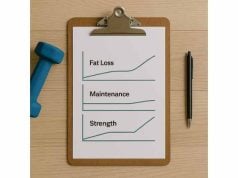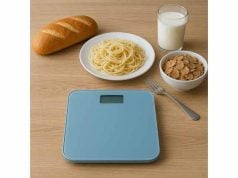
When the scale stalls, most people slash calories and hope for the best. That often backfires: energy drops, training quality fades, and weekend overeating erases weekday effort. A smarter plan is to run a structured checklist first. Many plateaus are measurement noise or behavior drift, not metabolism failure. This guide shows you how to confirm a true stall, fix the highest-impact variables, and decide—only after the basics are airtight—whether a calorie change is warranted. If you are currently troubleshooting or moving between deficit and maintenance, our step-by-step plateau and maintenance troubleshooting pairs well with the framework below.
Table of Contents
- What counts as a true plateau
- The plateau checklist: 12 fixes
- Food accuracy and structure
- Movement, NEAT and steps
- Sleep, stress and recovery
- Hormones, medications and health
- When to adjust calories safely
- Frequently Asked Questions
What counts as a true plateau
A true plateau is a flat trend, not a few noisy days. Sodium, glycogen, travel, menstrual phase, constipation, and late meals can hide fat loss for one to three weeks. Before changing your plan, confirm whether the stall is real.
How to confirm a plateau (2–4 weeks)
- Daily weigh-ins, weekly averages. Compare week-over-week averages for at least two—ideally four—weeks.
- Tape measurements. Track waist (narrowest or at navel) and hips weekly, morning, same conditions.
- Photos and clothes fit. Biweekly front/side/back photos and a simple “fit kit” (anchor jeans, a fitted top).
- Inputs audit. Steps, training sessions, and protein/fiber averages for the same period.
What a false plateau looks like
- Weight average is flat for one week, but waist drops 0.5–1.0 cm and clothes fit easier.
- A spike after a high-sodium meal, a late workout, or poor sleep.
- A single tough week at work where steps and sleep dropped.
What a true plateau looks like
- Two to four weeks of flat weight averages, no change at the waist or hips, photos unchanged, and clothes feel the same—with consistent steps, training, protein, and sleep.
Why this matters
Cutting calories too soon increases hunger and fatigue and often triggers weekend compensation. Confirm the stall first, then fix process issues (steps, protein, structure, sleep) before touching intake. If you need a refresher on fundamentals, skim our concise weight loss guide to align calories, protein, and movement with your goals.
The plateau checklist: 12 fixes
Run these 12 items in order. Most plateaus break without deeper cuts once these are consistent for two weeks. If you want a structured way to confirm the stall window, see how to check the stall in 2–4 weeks.
- Confirm the stall. Use weekly weight averages, waist/hip tape, photos, and clothes fit. Judge trends over 14–28 days.
- Tighten tracking accuracy. Weigh calorie-dense foods (oils, nut butters, dressings). Log cooking fats, condiments, and “bites and tastes.” Pre-portion snacks.
- Hit the protein floor. Aim for 1.6–2.2 g/kg of goal body weight daily. Anchor 25–40 g protein at breakfast and lunch. Protein steadies appetite and preserves lean mass.
- Raise fiber and volume. Target 25–35 g fiber/day from vegetables, fruit, legumes, and whole grains. Build plates with half produce, a palm of lean protein, and a fist of carbs.
- Audit liquid calories. Track alcohol, specialty coffees, smoothies, and fruit juice. Replace one drink or sugar-sweetened beverage with water or diet options.
- Close the weekend gap. Weekends often erase weekday deficits. Pre-log social meals, plan a protein-forward brunch, and keep a step floor.
- Structure meals and snacks. Eat seated, plate meals, and keep screens off while eating. Use a planned 150–250 kcal evening snack (Greek yogurt + fruit; apple + cottage cheese).
- Set a NEAT floor. Establish a minimum step baseline (e.g., 7–9k) and add +1–2k during cuts. Attach 10–12 minute walks to meals and calls.
- Match training to recovery. Lift 3–5×/week; keep most working sets at RPE 7–8; remove junk volume; maintain frequency over heroics.
- Add low-strain cardio if needed. Two to four 20–40 minute easy sessions (walking, cycling) stabilize expenditure without spiking hunger.
- Repair sleep and caffeine timing. Fixed wake time, 7–9 hours in bed, and caffeine cutoff 8–10 hours before sleep. Poor sleep increases water retention and cravings.
- Account for sodium and cycle shifts. Expect 0.5–2.0 lb water swings after salty meals, travel, or during luteal phase. Judge progress by weekly averages and measurements.
Work this list faithfully for two weeks. If the trend is still flat, use the decision tree in Section 7 to choose the smallest effective calorie change.
Food accuracy and structure
Calories determine fat loss; accuracy and structure determine adherence. Plateaus often reflect silent overages—usually from fats, alcohol, and grazing—combined with low daytime protein.
Close the biggest gaps first
- Cooking fats and dressings. Weigh or pre-measure oils; switch to spray or broth where appropriate. Portion dressings; log them consistently.
- Snack creep. Replace open-bag snacking with pre-portioned options (single-serve nuts, measured cereal).
- Alcohol. Plan drinks. Favor spirits with zero-calorie mixers or dry wine. Finish alcohol 3–4 hours before bed to protect sleep.
Build plates that drive satiety
- Protein: 25–40 g per meal (lean poultry, fish, eggs, Greek yogurt, tofu/tempeh).
- Fiber and volume: one to two cups of vegetables or fruit at each meal; include legumes or whole grains.
- Carbs around training: place 30–50% of carbs in the window 90 minutes pre- to 60 minutes post-workout for performance without late-night overeating.
Meal timing that steadies appetite
- Front-load protein at breakfast and lunch.
- Use a planned evening snack if nights are risky.
- Keep a consistent 12-hour eating window if late grazing is a problem.
Two-week structure sprint
- Choose two breakfasts and two lunches you can repeat.
- Pre-log dinner and your snack by noon.
- Batch a high-protein staple (chili, shredded chicken, tofu bake) every Sunday.
For more ideas that add volume without calories, see targeted tactics in protein and fiber during plateaus.
Movement, NEAT and steps
NEAT (non-exercise activity thermogenesis) is often the hidden lever in a plateau. During cuts, spontaneous movement drops: fewer posture changes, shorter errands, more sitting. Steps are the simplest way to stabilize daily burn.
Build a movement floor
- Find your 14-day step average; set a floor you will hit even on busy days.
- Add +1–2k during a cut and attach steps to anchors: after meals, first 10 minutes of calls, a 12-minute evening loop.
- Use indoor options (treadmill, mall loops) for weather and safety.
Add cardio with intention
- Two to four 20–40 minute easy sessions weekly (walk, cycle, elliptical).
- Keep intensity conversational; save hard intervals for maintenance phases.
Why it works
- Steps prevent the “hidden” drift that erases deficits.
- Easy cardio supports mood and sleep without large appetite spikes.
If your movement reliably dips when dieting, read our practical playbook on preventing NEAT drops to hold your baseline through tough weeks.
Sleep, stress and recovery
Short sleep and high stress can keep the scale flat even while fat loss continues. They also erode training quality and increase cravings.
What to fix this week
- Wake time first. Anchor a fixed wake time seven days a week; add 30–60 minutes in bed for two weeks.
- Morning light + short walk. Get daylight within an hour of waking; move 10–20 minutes to set your clock.
- Caffeine cutoff. Stop stimulants 8–10 hours before bed.
- Wind-down routine. 30–60 minutes of low-arousal activities, dim lights, warm shower, book.
Training on low sleep
- Keep frequency; cap sets at RPE 7–8; prefer low-skill accessories; fuel with a small carb dose pre-lift.
Scale sanity
- Expect 0.5–2.0 lb spikes after poor sleep. Trust weekly averages and measurements.
For a complete recovery framework that un-stalls fat loss, see how to repair sleep and cortisol.
Hormones, medications and health
Sometimes a plateau is not a math problem. Health factors and prescriptions can affect appetite, fluid balance, or energy expenditure.
When to talk with your clinician
- Loud snoring, gasping, or unrefreshing sleep despite adequate time in bed (possible sleep apnea).
- Persistent fatigue, cold intolerance, hair loss, or unusual weight changes (ask about thyroid and iron status).
- New or adjusted medications linked to weight change (certain antidepressants, antipsychotics, steroids, beta-blockers, and more).
- Perimenopause symptoms that shift hunger, mood, or sleep; your plan may need pacing and recovery adjustments.
What to bring
- Two-week logs for sleep, steps, protein, alcohol, and weight averages.
- A medication list with timing and doses.
Use our conversation checklist to review common culprits in medications linked to plateaus and discuss alternatives or dose timing with your clinician.
When to adjust calories safely
If you have run the checklist for two solid weeks—protein, fiber, steps, sleep, and training are consistent—and your weight averages, measurements, photos, and clothes fit are unchanged, you have a real plateau. Now choose the smallest effective change.
Option A: Add movement first
- Increase your step average by +1–2k/day or add two 20–30 minute easy cardio sessions weekly.
- Hold for two weeks and reassess.
Option B: Trim calories modestly
- Reduce 100–200 kcal/day from carbs or fats (not protein).
- Keep meal structure and training intact; watch two- to three-week trends.
Option C: Short maintenance phase
- Spend 1–2+ weeks at calculated maintenance to restore training quality and mood, then resume a small deficit.
- Keep protein high and steps/training steady.
- This is not “giving up”; it’s consolidating progress and preventing rebound.
What not to do
- Large, sudden cuts that spur binge-restrict cycles.
- Slashing carbs on training days without replacing with structure and protein.
- Adding punishing cardio that wrecks sleep and adherence.
Decision rule: change one lever at a time, hold two to three weeks, and judge by averages and measurements, not one day.
Frequently Asked Questions
How long should I wait before calling it a plateau?
Use weekly averages for weight plus waist/hip measurements. If all are flat for 2–4 weeks with consistent steps, training, protein, and sleep, treat it as a true plateau and make a small, targeted change. Do not react to one noisy week.
Which single fix breaks the most plateaus?
The biggest wins usually come from protein, steps, and sleep. Hitting 1.6–2.2 g/kg protein, adding +1–2k steps/day, and sleeping 7–9 hours often restart loss without deeper cuts. Many stalls vanish when weekends and alcohol are structured.
Should I add cardio or cut calories first?
Add low-strain cardio or increase steps first. If movement and structure are solid for two weeks and the trend is still flat, trim 100–200 kcal/day from carbs or fats. Small, patient changes preserve training and adherence.
How do I handle weekend eating without ruining progress?
Plan ahead. Pre-log the main meal, anchor protein at brunch, set a drink budget, and keep a step floor. A planned 150–250 kcal evening snack prevents grazing. One consistent weekend beats two “perfect” weekdays and a free-for-all.
Why is my waist smaller but weight unchanged?
Water, glycogen, and digestion can mask fat loss. If your waist and clothes improve while weight holds, you are likely losing fat and perhaps gaining some muscle. Trust measurements and photos; judge by two- to four-week trends.
When should I pause the deficit?
Pause when strength and mood slide for 3+ weeks despite solid sleep, protein, and steps, or when adherence is fraying. Spend 1–2+ weeks at maintenance to restore training quality, then resume with a smaller deficit and clear structure.
References
- Effect of Sleep Extension on Objectively Assessed Energy Intake Among Adults With Overweight in Real-life Settings: A Randomized Clinical Trial — 2022 (RCT)
- Protein Intake Greater than the RDA Differentially Influences Whole-Body Lean Mass Responses to Purposeful Catabolic and Anabolic Stressors: A Systematic Review and Meta-analysis — 2020 (Systematic Review)
- Can dietary viscous fiber affect body weight independently of an energy-restrictive diet? A systematic review and meta-analysis of randomized controlled trials — 2020 (Systematic Review)
- WHO guidelines on physical activity and sedentary behaviour — 2020 (Guideline)
- Pharmacotherapy causing weight gain and metabolic alteration in those with obesity and obesity-related conditions: A review — 2024 (Review)
Medical Disclaimer
This guide provides general education on fat-loss plateaus, nutrition, movement, and recovery. It is not a substitute for professional medical advice, diagnosis, or treatment. Always consult your licensed healthcare provider before changing your diet, exercise program, or medications—especially if you have chronic conditions or take prescription drugs.
Share and Follow
If this checklist helped you get unstuck, consider sharing it with a friend who is fighting the same stall. You are also welcome to follow us on Facebook, X, or whatever network you use most for practical updates and new step-by-step guides.










